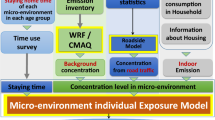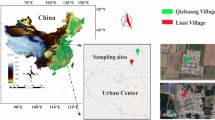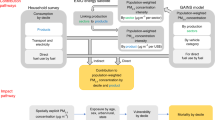Abstract
The coal-dominated fossil fuel has sustained China’s rapid development in the last 30 years. However, the massive coal combustion also contributed to a heavy burden of illness and health damage through air pollution. Currently, the main air pollutant particulate and sulfur levels in major Chinese cities are among the highest worldwide, and China is the largest source of SO2 emission in the world. For the sustainable development and harmonious society building, it is necessary and urgent to assess the health impacts caused by China’s air pollution. The intake fraction is a relatively new measure to assess the health risk caused by air pollution. It can capture the relationship between pollution source and the specific health impacts. We applied the intake fraction and dose–response relationship to estimate Chinese urban people health impacts and assess the economic loss of these impacts from the perspective of sector level. According to our estimation, the health impacts accounted for between 0.82 and 4.85% of 2007 GDP if only combustion emission was included. The electricity, some tertiary sectors, coking, non-metal material, paper, transportation, and ferrous sectors contributed most to the damage.



Similar content being viewed by others
Notes
The full version of the modified iF value can be obtained by contacting the author.
References
Bennett DH, McKone TE et al (2002) Defining intake fraction. Environ Sci Technol 36(9):207A–211A
Chen R, Chu C et al (2010) Ambient air pollution and hospital admission in Shanghai, China. J Hazard Mater 181(1–3):234–240
Fang B (2010) The comprehensive assessment methods for China’s energy environmental health effects and their application. Chin Acad Sci 17–40
Guo XR, Cheng SY et al (2010) Estimation of economic costs of particulate air pollution from road transport in China. Atmos Environ 44(28):3369–3377
Hammitt JK, Zhou Y (2006) The economic value of air-pollution-related health risks in China: a contingent valuation study. Environ Resource Econ 33(3):399–423
Hao J, Wang L et al (2007) Air quality impacts of power plant emissions in Beijing. Environ Pollut 147(2):401–408
Ho MS (2007) Appendix G. Supplementary Details for National Sector Damage Estimates. Clearing the air. The health and economic damages of air pollution in China. Cambridge, MIT Press
Ho MS, Jorgenson DW (2007) Sector allocation of emissions and damage. Clearing the air. The health and economic damages of air pollution in China. Cambridge, MIT Press
Ho MS, Nielsen CP (2007) Clearing the air: the health and economic damages of air pollution in China. Cambridge, Massachusetts London, England, The MIT Press
Humbert S, Manneh R et al (2009) Assessing regional intake fractions in North America. Sci Total Environ 407(17):4812–4820
Lindhjem H, Hu T et al (2007) Environmental economic impact assessment in China: problems and prospects. Environ Impact Assess Rev 27(1):1–25
Luo Z, Li Y et al (2010) Intake fraction of nonreactive motor vehicle exhaust in Hong Kong. Atmos Environ 44(15):1913–1918
Marshall JD, Riley WJ et al (2003) Intake fraction of primary pollutants: motor vehicle emissions in the South Coast air Basin. Atmos Environ 37(24):3455–3468
Marshall JD, Teoh S-K et al (2005) Intake fraction of nonreactive vehicle emissions in US urban areas. Atmos Environ 39(7):1363–1371
Nazaroff WW (2008) Inhalation intake fraction of pollutants from episodic indoor emissions. Build Environ 43(3):269–277
NBS (2009) China statistical yearbook 2009. China Statistial Press, Beijing
NBS (2009) Input-output tables of China. China Statistics Press, Beijing
NBS and MEP (2008) China statistical yearbook of environmental. China Statistics Press, Beijing
NBS and NEA (2008) China energy statistical yearbook. China Statistics Press, Beijing
Russo JS, Ezzat Khalifa H (2010) CFD assessment of intake fraction in the indoor environment. Build Environ 45(9):1968–1975
SEPA and NBS (2006) China green national accounting study report 2004 (Public Version). Beijing
Stevens G, de Foy B et al (2007) Developing intake fraction estimates with limited data: comparison of methods in Mexico city. Atmos Environ 41(17):3672–3683
Tainio M, Tuomisto JT et al (2010) Uncertainty in health risks due to anthropogenic primary fine particulate matter from different source types in Finland. Atmos Environ 44(17):2125–2132
Wang X, Mauzerall DL (2006) Evaluating impacts of air pollution in China on public health: implications for future air pollution and energy policies. Atmos Environ 40(9):1706–1721
Wang S, Hao J et al (2006) Intake fractions of industrial air pollutants in China: estimation and application. Sci Total Environ 354(2–3):127–141
Watts J (2005) China: the air pollution capital of the world. Lancet 366(9499):1761–1762
Wei Y, Liu LC et al (2010a) Energy economics: CO2 emissions in China. Springer, Heidelberg
Wei Y, Fan Y et al (2010b) Energy economics: modeling and empirical analysis in China. Taylor & Francis Group, New York
Wilkinson P, Smith KR et al (2007) A global perspective on energy: health effects and injustices. Lancet 370(9591):965–978
World Bank (1997) Clear SKY, blue skies: China’s environment in the new century. Washington, DC
World Bank (2007) Cost of pollution in China: economic estimates of physical damages. Wahsington, DC
Xinhuanet (2010) China’s eleventh five-year emission reduction targets achieved ahead of schedule. From http://news.xinhuanet.com/fortune/2010-11/30/c_13628755.htm
Zhang M, Song Y et al (2008) Economic assessment of the health effects related to particulate matter pollution in 111 Chinese cities by using economic burden of disease analysis. J Environ Manag 88(4):947–954
Zhou Y, Levy JI et al (2003) Estimating population exposure to power plant emissions using CALPUFF: a case study in Beijing, China. Atmos Environ 37(6):815–826
Zhou Y, Levy JI et al (2006) The influence of geographic location on population exposure to emissions from power plants throughout China. Environ Int 32(3):365–373
Acknowledgments
The authors gratefully acknowledge the financial support from the National Natural Science Foundation of China under Grant no. 70733005 and 71020107026, the CAS Strategic Priority Research Program Grant no. XDA05150600, and SRFDP under the grant no. 20091101110044. We also would like to thank Professor T.S. Murty and the anonymous referees for their helpful suggestions and corrections on the earlier draft of our paper according to which we improved the content.
Author information
Authors and Affiliations
Corresponding author
Rights and permissions
About this article
Cite this article
Fang, B., Liu, CF., Zou, L.L. et al. The assessment of health impact caused by energy use in urban areas of China: an intake fraction–based analysis. Nat Hazards 62, 101–114 (2012). https://doi.org/10.1007/s11069-011-9936-z
Received:
Accepted:
Published:
Issue Date:
DOI: https://doi.org/10.1007/s11069-011-9936-z




